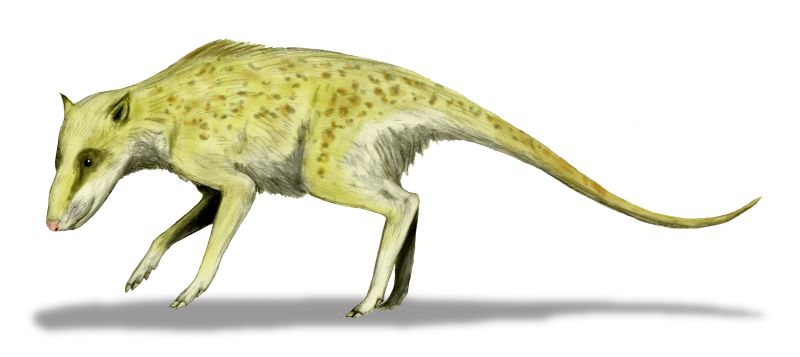- Indohyus
Taxobox
name = "Indohyus"
fossil_range = MiddleEocene

image_width = 250px
image_caption = "Indohyus major"
regnum =Animal ia
phylum =Chordata
classis =Mammal ia
ordo =Artiodactyla
familia = ?Raoellidae
genus = "Indohyus"
genus_authority = Rao, 1971
subdivision_ranks = Species
subdivision ="Indohyus indirae "
"Indohyus major ""Indohyus" ("
India 's pig") is agenus of extinctartiodactyl known fromEocene fossil s in Asia, purported to be approximately 48 million years old. A December 2007 article in "Nature" by Thewissen "et al." using an exceptionally complete skeleton of "Indohyus" fromKashmir indicates that raoellids may be the "missing link " sister group to whales (Cetacea ). [cite journal |last=Thewissen |first=J. G. M. |authorlink= |coauthors= |year=2007 |month= |title=Whales originated from aquatic artiodactyls in the Eocene epoch of India |journal=Nature |volume=450 |issue=7173 |pages=1190–1194 |doi=10.1038/nature06343 |url= |accessdate= |quote= ] [cite web
url=http://www.sciam.com/article.cfm?id=closest-whale-cousin
title=Closest Whale Cousin—A Fox-Size Deer? Researchers split on closest evolutionary kin to whales and dolphins
first=JR
last=Minkel
publisher=Scientific American
date=2007-12-19] All otherArtiodactyla are "cousins" of these two groups. δ18O values andosteosclerotic bones indicate that theraccoon -like orchevrotain -like "Indohyus" was habitually aquatic, but δ13C values suggest that it rarely fed in the water. The authors suggest this documents an intermediate step in the transition back to water completed by the whales, and suggests a new understanding of theevolution of cetaceans .The fossils were discovered among rocks that had been collected more than 30 years ago in
Kashmir by the Indian geologistA Ranga Rao who found a few teeth and parts of a jawbone, but when he died many rocks had yet to be broken open. Ranga Rao's widow gave the rocks to Professor Thewissen, who was working on them when his technician accidentally broke one of the skulls they had found and Thewissen recognised the ear structure of theauditory bulla , formed from theectotympanic bone in a shape which is highly unusual and only resembles the skulls of whales and the earlier land creature "Pakicetus ".However, not all
paleontologists are firmly persuaded that "Indohyus" is thetransitional fossil that cetacean-origin experts were looking for. "ScienceNOW", a daily news feature of the journal "Science", notes that a team set to publish in the journal "Cladistics" postulates an extinct group of carnivorous mammals called "mesonychids" as more closely related to cetaceans. Additionally, the "Science"NOW article notes that "cetaceans are so different from any other creature that researchers haven’t been able to agree which fossil relatives best represent their nearest ancestors." [cite web |url=http://sciencenow.sciencemag.org/cgi/content/full/2007/1219/2 |title=Long-Lost Relative of Whales Found? |accessdate=2007-12-27 |last=Stokstad |first=Erik |coauthors= |date=2007-12-19 |work="Science"NOW Daily News |publisher=]About the size of a raccoon or domestic cat, this herbivorous deer-like creature shared some of the traits of whales, and showed signs of adaptations to aquatic life, including a thick and heavy outer coating to bones which is similar to the bones of modern creatures such the
hippopotamus , and reduces buoyancy so that they can stay underwater. This suggests a similar survival strategy to the African mousedeer or water chevrotain which, when threatened by a bird of prey, dives into water and hides beneath the surface for up to four minutes.cite web |url=http://scienceblogs.com/loom/2007/12/19/whales_from_so_humble_a_beginn.php |title=The Loom : Whales: From So Humble A Beginning... |accessdate=2007-12-21 |author=Carl Zimmer |authorlink=Carl Zimmer |date=December 19, 2007 |publisher=ScienceBlogs ] cite web |url=http://www.guardian.co.uk/science/2007/dec/19/whale.deer?gusrc=rss&feed=networkfront |title=Whales may be descended from a small deer-like animal | Science | Guardian Unlimited |accessdate=2007-12-21 |author=Ian Sample |date=December 19, 2007 |work= |publisher=Guardian Unlimited ] cite web |url=http://scienceblogs.com/pharyngula/2007/12/indohyus.php |title=Pharyngula: Indohyus |accessdate=2007-12-21 |author=PZ Myers |authorlink=PZ Myers |date=December 19, 2007 |work=Pharyngula |publisher=ScienceBlogs ]Taxonomy
Two species have been described.
*Genus "Indohyus "
**"Indohyus indirae "
**"Indohyus major "References
Wikimedia Foundation. 2010.
